Legion of Honor (museum)
The Legion of Honor, formally known as the California Palace of the Legion of Honor, is a part of the Fine Arts Museums of San Francisco[1] (which also administers the de Young Museum). The name is used both for the museum collection and for the building in which it is housed.
 | |
 Location within San Francisco | |
| Established | 1924 |
|---|---|
| Location | 100 34th Avenue, San Francisco, California, United States of America |
| Coordinates | |
| Type | Art museum |
| Collections | Ancient artifacts; European art, crafts, ceramics, and furnishings; Achenbach Foundation for Graphic Arts |
| Architect | George Applegarth and Henri Guillaume (1924), Edward Larrabee Barnes and Mark Cavagnero (1995) |
| Website | http://legionofhonor.famsf.org/ |
History
_01.jpg.webp)
The Legion of Honor was the gift of Alma de Bretteville Spreckels, wife of the sugar magnate and thoroughbred racehorse owner/breeder Adolph B. Spreckels.[2]:9–10 The building is a full-scale replica, by George Applegarth and Henri Guillaume, of the French Pavilion at the 1915 Panama–Pacific International Exposition, which in turn was a three-quarter-scale version of the Palais de la Légion d'Honneur (also known as the Hôtel de Salm) in Paris, by Pierre Rousseau (1782). At the close of the exposition, which was located just a few miles away, the French government granted Spreckels permission to construct a permanent replica of the French Pavilion. World War I delayed the groundbreaking until 1921. Dedicated as a memorial to California soldiers killed in the war,[2]:7 the museum opened on Armistice Day, November 11, 1924.[3]
The museum building occupies an elevated site in Lincoln Park in the northwest of the city, with views over the nearby Golden Gate Bridge and the distant downtown skyline.

Between March 1992 and November 1995 the Legion underwent a major renovation that included seismic strengthening, building systems upgrades, restoration of historic architectural features, and an underground expansion that added 35,000 square feet. The Court of Honor was pierced by a pyramidal skylight opening onto the new gallery space below, a quotation in miniature of the Louvre Pyramid. The architects for the project were Edward Larrabee Barnes and Mark Cavagnero.[3]
The plaza and fountain in front of the Legion of Honor is the western terminus of the Lincoln Highway, the first improved road for automobiles across America. The terminus marker and an interpretive plaque are located in the southwest corner of the plaza and fountain, just to the left of the Palace. Dominating the classical plaza is Pax Jerusalemme, a modern sculpture by Mark di Suvero that stirred controversy at its installation in 2000.[4]
Collections

The Legion of Honor displays a collection spanning more than 6,000 years of ancient and European art and houses the Achenbach Foundation for Graphic Arts.
The Hall of Antiquities displays ancient works from Egypt, the Near East, Greece, and Rome, including sculptures, figurines, vessels, jewelry, and carved reliefs. Notable works include a 4,000-year-old carved wood figure of Seneb, an Egyptian royal scribe. The collection is supported in part by the Ancient Art Council, which offers a speakers program focusing on the ancient world.[5][6]
The museum contains a representative collection of European art, the largest portion of which is French. Its most distinguished collection is of sculpture by Auguste Rodin. Casts of some of his most famous works are on display, including one of The Thinker in the Court of Honor. Other artists in the collection include El Greco, Titian, Rubens, Rembrandt, Boucher, David, Tiepolo, Gainsborough and many of the Impressionists and post-Impressionists—Degas, Renoir, Monet, Pissarro, Seurat, Cézanne, van Gogh and others.

The Achenbach Foundation for Graphic Arts (AFGA) is responsible for the museum's collection of works on paper. With more than 90,000 items, the AFGA is the largest repository of works of art on paper in the western United States. The department is named for Moore and Hazel Achenbach, who gave the bulk of their collection to the city of San Francisco in 1948, and the remainder upon Moore Achenbach’s death in 1963. Many additional acquisitions form the basis for special collections within the department, such as the Anderson Collection of Graphic Arts.[7] Selections from the Logan collection, more than 400 books dating from the nineteenth century to the present, are regularly used in exhibitions in the Reva and David Logan Gallery of Illustrated Books located in a small room off the Hall of Antiquities.[8]
The museum's collection of European Decorative Arts includes a gilded Spanish ceiling from c. 1500; numerous items of furniture, including Horace Walpole’s commode of 1763 from Strawberry Hill House, west of London; and three period rooms, including the Salon Doré from the Hôtel de La Trémoille, Paris, said to be the only complete example of a pre-Revolutionary Parisian salon to be displayed anywhere.[9][10]
The Bowles Porcelain Gallery displays an array of porcelain and pottery from England and continental Europe with a strong emphasis on the eighteenth century. Adjacent to the gallery is the Ceramic Study Center.[11]
The Contemporary Arts Program, which brings the work of living artists into dialogue with the building and the collections, was inaugurated in 2017 with an exhibition of more than 30 works by Urs Fischer installed throughout the museum.[12] Subsequent exhibitions have featured works and interventions by artists including Lynn Hershman Leeson,[13] Julian Schnabel,[14] and Alexandre Singh.[15]
Situated off the northwest corner of the Legion grounds is the Holocaust Memorial, a sculptural group of white-painted bronze by George Segal installed in 1984. Although not part of the Legion's collection, the sculpture is often seen by visitors to the museum.
Symphonic Organ and Gunn Theater

In 1924, John D. Spreckels commissioned the Ernest M. Skinner Company of Boston to build the symphonic organ, which is centrally located in the Spreckels Gallery (gallery 10). It was designed to blend into the museum's structure; its 4,500 pipes are not visible to visitors. The ceiling of the gallery is canvas so that the organ can be heard throughout the gallery and museum; the canvas ceiling is painted as a trompe-l'œil to resemble a marble apse.[16] Organ concerts are performed every Saturday at 4:00 p.m.[17]
The 316-seat James A. and Cynthia Fry Gunn Theater, located downstairs off the Hall of Antiquities, is a venue for chamber music concerts by the San Francisco Symphony and for lectures and other programs. Architect George Applegarth designed the circular theater and decorated it in the style of Louis XVI. The descending entrance stairways on either side are decorated with portraits by Nicolas de Largillière.[18][19] The ceiling mural is The Apotheosis of the California Soldier by Spanish artist Julio Vila y Prades.[2]:95
Film appearances
- The Legion of Honor is seen in the Alfred Hitchcock movie Vertigo (1958) when Scottie (played by James Stewart) follows Madeleine Elster (played by Kim Novak) to the museum, where she stares at one painting for a considerable time. The painting, a portrait of the fictitious Carlotta Valdes, was a prop created specifically for the production by artist John Ferren and is not housed at the museum.[20]
- The Legion of Honor appears in the 1993 miniseries Tales of the City, based on the first of the Tales of the City series of novels by Armistead Maupin. The character of Mary Ann Singleton (played by Laura Linney) arranges to meet her neighbor Norman Neal Williams (played by Stanley DeSantis) at the museum.
- The character Dr. Crippen (played by Signe Hasso) in The Black Bird, a 1975 comedy sequel to Maltese Falcon, has an office in the Legion of Honor.
Gallery
 Facade, stairway, and fountain.
Facade, stairway, and fountain.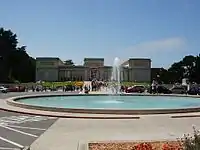 Circular fountain.
Circular fountain. Joan of Arc (1915) by Anna Hyatt Huntington on the Legion grounds.
Joan of Arc (1915) by Anna Hyatt Huntington on the Legion grounds. El Cid Campeador (1921) by Anna Hyatt Huntington on the Legion grounds.
El Cid Campeador (1921) by Anna Hyatt Huntington on the Legion grounds. Laocoön, Carrara marble reproduction of the ancient sculpture in the Vatican Museums.
Laocoön, Carrara marble reproduction of the ancient sculpture in the Vatican Museums.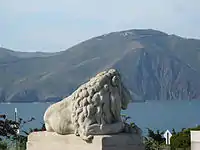 A view from the front steps.
A view from the front steps.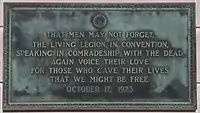 World War I bronze memorial plaque in the Court of Honor.
World War I bronze memorial plaque in the Court of Honor. The Thinker and the pyramidal skylight in the Court of Honor.
The Thinker and the pyramidal skylight in the Court of Honor. The Thinker (1904) by Auguste Rodin in the Court of Honor.
The Thinker (1904) by Auguste Rodin in the Court of Honor. Cycladic Figure, c. 2500 BCE, in the Hall of Antiquities.
Cycladic Figure, c. 2500 BCE, in the Hall of Antiquities. Anthropoid Coffin of Iret-hor-irou, Egyptian, 380–343 BCE.
Anthropoid Coffin of Iret-hor-irou, Egyptian, 380–343 BCE. Torso of Hermes, Roman, 2nd century AD.
Torso of Hermes, Roman, 2nd century AD. The Meeting of Saint Dominic and Saint Francis of Assisi (c. 1427–1429) by Fra Angelico.
The Meeting of Saint Dominic and Saint Francis of Assisi (c. 1427–1429) by Fra Angelico.
 Lucretia (c. 1525) by Joos van Cleve.
Lucretia (c. 1525) by Joos van Cleve.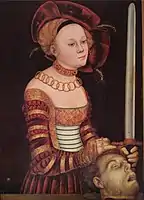 Portrait of a Lady of the Saxon Court as Judith with the Head of Holofernes (c. 1536-1540) by Lucas Cranach the Elder and Workshop.
Portrait of a Lady of the Saxon Court as Judith with the Head of Holofernes (c. 1536-1540) by Lucas Cranach the Elder and Workshop.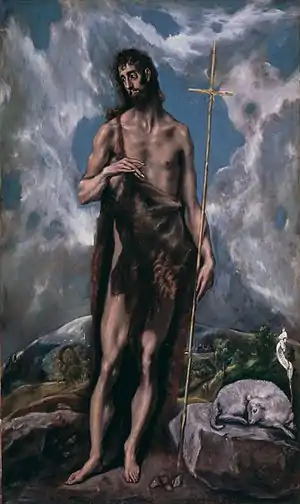 St. John the Baptist (c. 1600) by El Greco.
St. John the Baptist (c. 1600) by El Greco. The Tribute Money (c. 1610-1615) by Peter Paul Rubens.
The Tribute Money (c. 1610-1615) by Peter Paul Rubens.
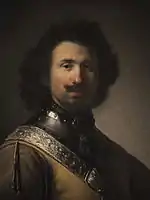 Joris de Caulerij (1632) by Rembrandt.
Joris de Caulerij (1632) by Rembrandt.
 Landscape with Travellers (c. 1640) by Salvator Rosa.
Landscape with Travellers (c. 1640) by Salvator Rosa.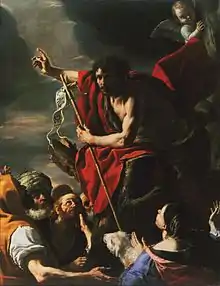 St John the Baptist Preaching (c. 1665) by Mattia Preti.
St John the Baptist Preaching (c. 1665) by Mattia Preti..jpg.webp) The Empire of Fora (1743) by Giovanni Battista Tiepolo.
The Empire of Fora (1743) by Giovanni Battista Tiepolo. Mrs. Maria Anne Fitzherbert (1784) by Thomas Gainsborough.
Mrs. Maria Anne Fitzherbert (1784) by Thomas Gainsborough. The Dead Soldier (1789) by Joseph Wright of Derby.
The Dead Soldier (1789) by Joseph Wright of Derby. Don Ramón de Posada y Soto (c. 1801) by Goya.
Don Ramón de Posada y Soto (c. 1801) by Goya. The Wave (c. 1869) by Gustave Courbet.
The Wave (c. 1869) by Gustave Courbet..jpg.webp)
 Love and the Maiden (1877) by John Roddam Spencer Stanhope.
Love and the Maiden (1877) by John Roddam Spencer Stanhope. Waves Breaking (1881) by Claude Monet.
Waves Breaking (1881) by Claude Monet. The Bath (c. 1880-1885) by Jean-Léon Gérome.
The Bath (c. 1880-1885) by Jean-Léon Gérome. The Russian Bride's Attire (1889) by Konstantin Makovsky.
The Russian Bride's Attire (1889) by Konstantin Makovsky. Landscape at Beaulieu (1893) by Pierre-Auguste Renoir.
Landscape at Beaulieu (1893) by Pierre-Auguste Renoir. Forest Interior (c. 1898-1899) by Paul Cézanne.
Forest Interior (c. 1898-1899) by Paul Cézanne. Vase of Flowers (1901) by Odilon Redon.
Vase of Flowers (1901) by Odilon Redon.
 Table (c. 1670-1690) attributed to Andre-Charles Boulle.
Table (c. 1670-1690) attributed to Andre-Charles Boulle. Von Gymnich mirror (c. 1740), Germany.
Von Gymnich mirror (c. 1740), Germany.
_%2526_World_Globes_(Netherlands).JPG.webp) 17th century oak table (Italy) with terrestrial globe and celestial globe by Joducus Hondius c. 1600.
17th century oak table (Italy) with terrestrial globe and celestial globe by Joducus Hondius c. 1600. Vintage postcard.
Vintage postcard. Vintage postcard.
Vintage postcard. Vintage postcard.
Vintage postcard. Vintage postcard: Rodin's "The Thinker" in the Court of Honor.
Vintage postcard: Rodin's "The Thinker" in the Court of Honor.%252C_1972.jpg.webp) Ruth Asawa's San Francisco Fountain (detail: Legion of Honor surmounted by Rodin's Thinker), 1972.
Ruth Asawa's San Francisco Fountain (detail: Legion of Honor surmounted by Rodin's Thinker), 1972.
References
- "About the Fine Arts Museums of San Francisco". www.famsf.org.
- Legion of Honor: Inside and Out. Fine Arts Museums of San Francisco, 2013.
- "History of the Legion of Honor". legionofhonor.famsf.org. Retrieved 2019-11-03.
- Baker, Kenneth (16 July 2000). "A Legion of Concerns Over Sculpture / Di Suvero's mediocre 'Pax Jerusalem' may signal a troubling trend at Fine Arts Museums". San Francisco Chronicle.
- "Ancient Art". Retrieved 2019-09-04.
- "Ancient Art Council".
- "Achenbach Foundation for Graphic Arts". Retrieved 2019-09-04.
- "Reva and David Logan Collection of Illustrated Books". Retrieved 2019-09-11.
- "European Decorative Arts". Retrieved 2019-09-06.
- "The Salon Doré". Retrieved 2019-09-06.
- "The Bowles Porcelain Gallery". Retrieved 2019-09-04.
- "Urs Fischer: The Public and the Private". Retrieved 2019-09-12.
- "Lynn Hershman Leeson: VertiGhost". Retrieved 2019-09-12.
- "Julian Schnabel: Symbols of Actual Life". Retrieved 2019-09-12.
- "Alexandre Singh: A Gothic Tale". Retrieved 2019-09-12.
- "The Skinner Organ". Legion of Honor. Retrieved November 12, 2012.
- Information accurate as of November 2019.
- "Portrait of a Gentleman". Retrieved 2019-09-13.
- "Portrait of a Lady". Retrieved 2019-09-13.
- "Lights, Camera, Action! Alfred Hitchcock's Vertigo at the Legion of Honor". Retrieved 2019-09-10.
- From the museum label: "This depiction of the female nude is perhaps the most provocative and frankly sensual of any produced in seventeenth-century France."
External links
| Wikimedia Commons has media related to California Palace of the Legion of Honor. |
.jpg.webp)